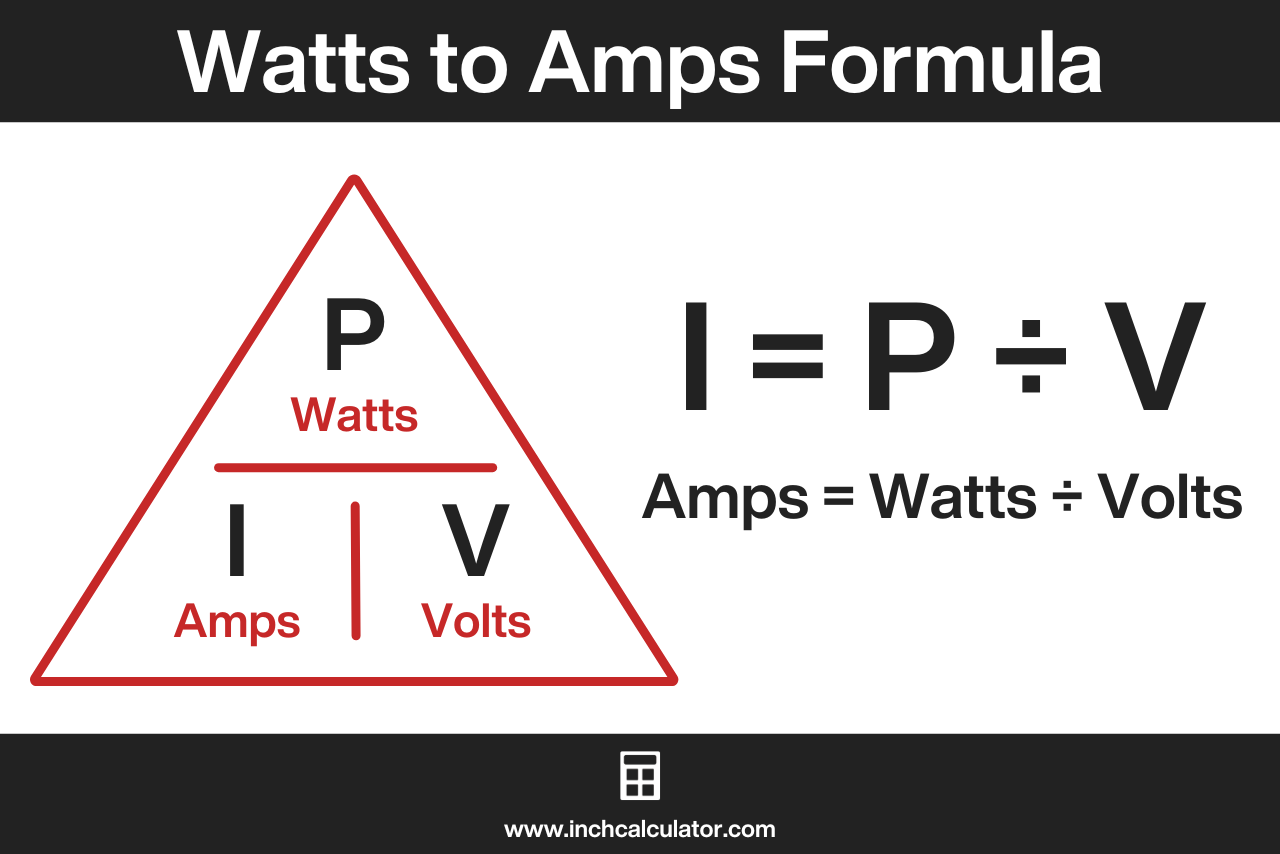Watts to Amps Conversion Calculator
Enter the power and voltage to convert watts to amps for DC, single-phase AC, and three-phase AC circuits.
On this page:
- Watts to Amps Calculator
- How to Convert Watts to Amps
- Watts to Amps Formula
- How Many Amps Are in a Watt?
- Conversion for Single-Phase AC Circuits
- Conversion for Three-Phase AC Circuits
- How to Convert Watts and Ohms to Amps
- Table: Watts to Amps at 120V & 240V AC
- Table: Watts to Amps at 12V DC
- References
How to Convert Watts to Amps
Converting watts to amps can be done using the Watt’s Law power formula, which states that the current is equal to the power divided by the voltage.
Watts to Amps Formula
Using Watt’s Law, you can find amps given power and voltage using the following formula:[1]
I(A) = P(W) / V(V)
Thus, the current I in amps is equal to the power P in watts divided by the voltage V in volts.

How Many Amps Are in a Watt?
Using the formula above, you can also calculate how many amps of current are drawn for each watt of power, depending on the circuit voltage. For example, at 120 volts, 0.008333 amps of current are drawn to generate 1 watt of power, and 0.8333 amps are drawn to generate 100 watts.
At 240 volts, 0.004167 amps of current are drawn to generate 1 watt of power, and 0.4167 amps are drawn to generate 100 watts.
Example: 1,500 Watts to Amps at 120V
For example, let’s calculate the current draw, or amperage, of a 1,500-watt microwave at 120 volts.
I(A) = 1,500 W ÷ 120 V
I(A) = 12.5 A
So, a 1,500-watt microwave will draw 12.5 amps of current at 120 volts.
Example: 2,000 Watts to Amps at 240V
For example, let’s calculate the current draw of a 2,000-watt electric heater at 240 volts.
I(A) = 2,000 W ÷ 240 V
I(A) = 8.33 A
So, a 2,000-watt heater will draw 8.33 amps of current at 240 volts.
Conversion for Single-Phase AC Circuits
Computing power from current for a single-phase AC circuit with a power factor uses a slightly different formula.
I(A) = P(W) / V(V) × PF
In other words, the current I in amps is equal to the power P in watts divided by the product of the voltage V in volts and the power factor PF. If you want to learn more about calculating power factor, try our power factor calculator.
Conversion for Three-Phase AC Circuits
The formulas to convert watts to amps for three-phase AC circuits are a bit different from the single-phase and DC formulas. Use the formulas below for line-to-line or line-to-neutral RMS voltages in a three-phase circuit.
Using Line-to-Line Voltage
For three-phase AC circuits where the line-to-line voltage is known, the formula to convert watts to amps is:[1][2]
I(A) = P(W) / VL-L(V) × PF × √3
The current I in amps is equal to the power P in watts divided by the product of the line-to-line voltage V in volts, the power factor PF, and the square root of 3.
Note that this formula measures the current draw for a single pair of wires in a three-phase system; to calculate the current for all three pairs, you need to multiply the result by three.
Using Line-to-Neutral Voltage
For three-phase AC circuits where the line-to-neutral voltage is known, the formula to convert watts to amps is:
I(A) = P(W) / VL-N(V) × PF × 3
The current I in amps is equal to the power P in watts divided by the product of line-to-neutral voltage V in volts, the power factor PF, and 3.
This formula calculates the current for all three wires in a three-phase system; to find the current for a single wire, you’ll need to divide the result by three.
How to Convert Watts and Ohms to Amps
It is also possible to convert watts to amps if the resistance of a simple resistive circuit is known by using this formula:[1]
I(A) = √(P(W) ÷ R(Ω))
The current I in amps is equal to the square root of the power P in watts divided by the resistance R in ohms.
It is not possible to convert watts directly to amps without also knowing voltage or resistance.
Because 1 kilowatt is equal to 1,000 watts, it is also possible to use the formulas above to convert kW to amps, but watts need to be converted to kW first. Use our kW to amps calculator to solve using kilowatts.
Table: Watts to Amps at 120V & 240V AC
| Power (Watts) | Current (Amps) | Voltage (Volts) |
|---|---|---|
| 50 watts | 0.4167 amps | 120 volts |
| 100 watts | 0.8333 amps | 120 volts |
| 150 watts | 1.25 amps | 120 volts |
| 200 watts | 1.667 amps | 120 volts |
| 250 watts | 2.083 amps | 120 volts |
| 300 watts | 2.5 amps | 120 volts |
| 350 watts | 2.917 amps | 120 volts |
| 400 watts | 3.333 amps | 120 volts |
| 450 watts | 3.75 amps | 120 volts |
| 500 watts | 4.167 amps | 120 volts |
| 600 watts | 5 amps | 120 volts |
| 700 watts | 5.833 amps | 120 volts |
| 800 watts | 6.667 amps | 120 volts |
| 900 watts | 7.5 amps | 120 volts |
| 1,000 watts | 8.333 amps | 120 volts |
| 1,100 watts | 9.167 amps | 120 volts |
| 1,200 watts | 10 amps | 120 volts |
| 1,300 watts | 10.833 amps | 120 volts |
| 1,400 watts | 11.667 amps | 120 volts |
| 1,500 watts | 12.5 amps | 120 volts |
| 1,600 watts | 13.333 amps | 120 volts |
| 1,700 watts | 14.167 amps | 120 volts |
| 1,800 watts | 15 amps | 120 volts |
| 2,400 watts | 20 amps | 120 volts |
| 3,600 watts | 30 amps | 120 volts |
| 2,400 watts | 10 amps | 240 volts |
| 3,600 watts | 15 amps | 240 volts |
| 4,800 watts | 20 amps | 240 volts |
| 7,200 watts | 30 amps | 240 volts |
| 9,600 watts | 40 amps | 240 volts |
| 12,000 watts | 50 amps | 240 volts |
| 14,400 watts | 60 amps | 240 volts |
| 16,800 watts | 70 amps | 240 volts |
| 19,200 watts | 80 amps | 240 volts |
| 21,600 watts | 90 amps | 240 volts |
| 24,000 watts | 100 amps | 240 volts |
Table: Watts to Amps at 12V DC
| Power (Watts) | Current (Amps) | Voltage (Volts) |
|---|---|---|
| 5 watts | 0.4167 amps | 12 volts |
| 10 watts | 0.8333 amps | 12 volts |
| 15 watts | 1.25 amps | 12 volts |
| 20 watts | 1.667 amps | 12 volts |
| 25 watts | 2.083 amps | 12 volts |
| 30 watts | 2.5 amps | 12 volts |
| 35 watts | 2.917 amps | 12 volts |
| 40 watts | 3.333 amps | 12 volts |
| 45 watts | 3.75 amps | 12 volts |
| 50 watts | 4.167 amps | 12 volts |
| 60 watts | 5 amps | 12 volts |
| 70 watts | 5.833 amps | 12 volts |
| 80 watts | 6.667 amps | 12 volts |
| 90 watts | 7.5 amps | 12 volts |
| 100 watts | 8.333 amps | 12 volts |
| 120 watts | 10 amps | 12 volts |
| 180 watts | 15 amps | 12 volts |
| 240 watts | 20 amps | 12 volts |
References
- Miller, C., NFPA's Electrical References, National Fire Protection Association, 2004, Jones & Bartlett Learning, 67-75. https://www.google.com/books/edition/NFPA_s_Electrical_References/raUyIi7i-asC
- Miller, C., Ugly’s Electrical References, 2020 Edition, 2020, Jones & Bartlett Learning, 16-23. https://books.google.com/books?id=1kS8DwAAQBAJ





